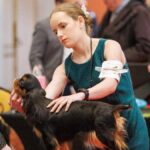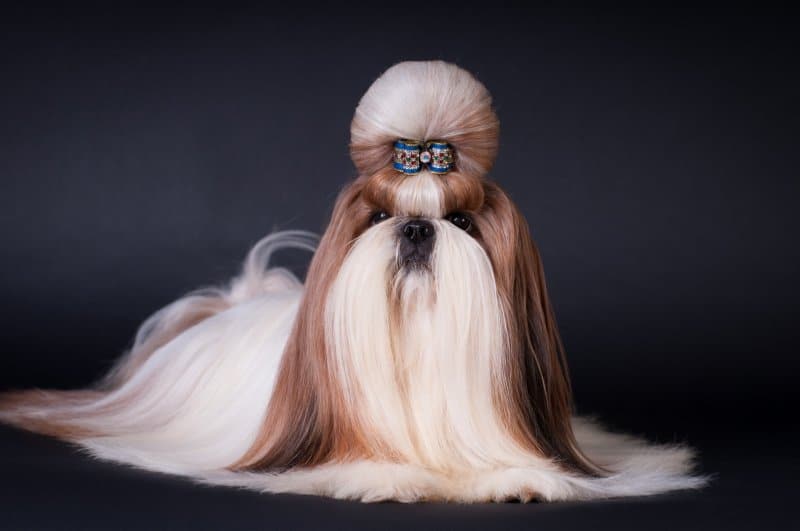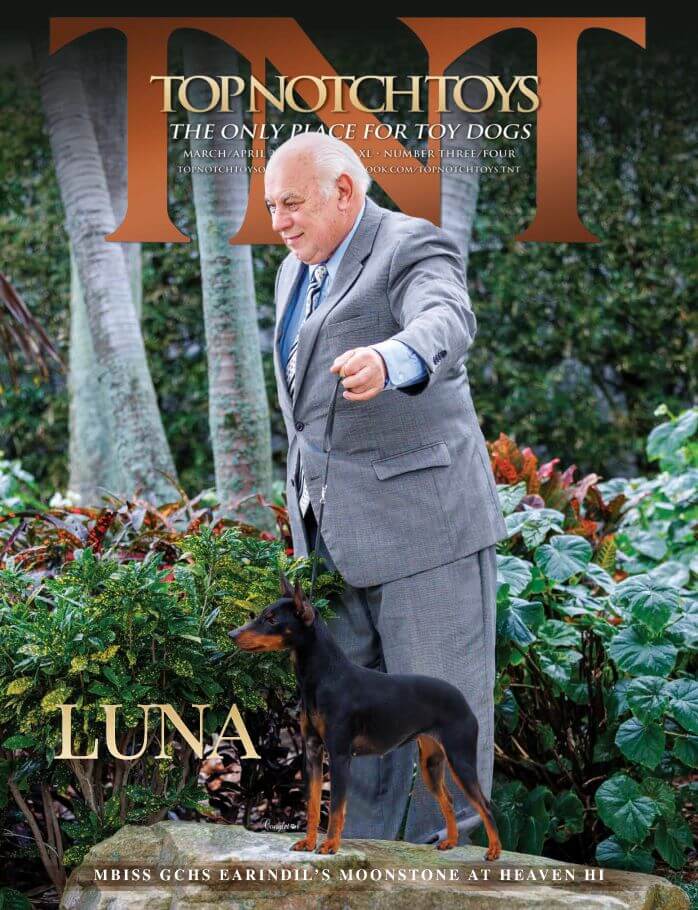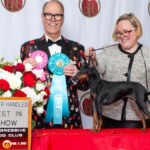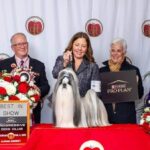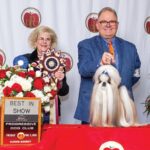The Responsibility of Judging Shih Tzu – A Top-Knotted and Drop-Coated Breed
(A version of this article appeared in the July 2012 edition of SHOWSIGHT.)
When the average person sees a show Shih Tzu for the first time, the only thing they likely see is a small drop-coated breed with a fancy topknot. But in reality, a Shih Tzu is so much more than that sole vision.
While the Shih Tzu has in many ways become a caricature compared to its former self, with the hours of primping and fussing that goes into what Shih Tzu exhibitors now consider as normal grooming for today’s competitive breed ring, it is in fact one of the most resplendent breeds in the show ring today. But that is only true if it is a correct and typical Shih Tzu under all that “window dressing.”
This article is intended only to help you get through all the hair, in particular the head and forequarters, two problem areas in our breed… I don’t endeavor to go through the entire standard word for word. At the American Shih Tzu Club’s website, we have an extensive list of articles written by longtime breeder judges and fellow ASTC Judges Education Committee members. Every article is timely, well written, and will help to increase your knowledge of this beautiful breed. In fact, nearly every writer is someone who themselves helped to shape my own mental template of perfection in the breed.
So what is a truly correct Shih Tzu to an aspiring or seasoned AKC judge really supposed to look like? Initially, any AKC standard might seem long and daunting, but the study of any breed can be much less challenging if you are able to sort out a few things. Our terrifically written standard makes it an easy task with the first two paragraphs under General Appearance.
The Shih Tzu is a lively, sturdy, alert Toy dog with long flowing double coat. Befitting his Chinese ancestry as a highly prized companion and palace pet, the Shih Tzu is proud of bearing, has a distinctively arrogant carriage with head well up and tail curved over the back. Although there has always been considerable size variation, the Shih Tzu must be compact, carrying good weight and substance.
Even though a Toy dog, the Shih Tzu must be subject to the same requirements of soundness and structure prescribed for all breeds, and any deviation from the ideal described in the standard should be penalized to the extent of the deviation. Structural faults common to all breeds are as undesirable in the Shih Tzu as in any other breed, regardless of whether or not such faults are specifically mentioned in the standard.
I commonly ask this question of attendees at Shih Tzu breed seminars I’m presenting: “If you are judging any smooth-haired breed that requires soundness, would you award championship points to an unsound example?” All answer no, of course. But in Shih Tzu judging, it is a common occurrence. I have always commented that the coat of a Shih Tzu is similar to a curtain on a theatre stage, hiding a multitude of flaws, both in the elaborate topknot grooming and the general structure.
The goal of the exhibitor is to carefully minimize faults so that none are found or exposed. If the judge fails to examine a dog fully or properly, he has done a disservice to the breed. The future of our breed is partially in your hands. If unsound animals are awarded points, it is entirely possible they will be used for breeding and the cycle of unsoundness continues.
The only way to ascertain if a Shih Tzu is truly sound and, hopefully, has a correct head is on the table examination. This isn’t a breed that can be judged from outside the ring; it is a hands-on adventure. Let’s continue to sort things out.
When you walk down the line-up of Shih Tzu, you initially look at the dogs with the standard in mind, focusing on the proper balance and outline, correct eye shape and color, and “nose to eye” placement. If you have studied the standard carefully, and if you have been fortunate to have seen quality dogs before, you shouldn’t have any problem sorting through the class.
The dogs are sent around the ring and I watch for balanced reach and drive, level toplines and a high-arched tail carriage, along with the head carried arrogantly, and lastly… not raced around the ring. Based on the cursory view prior to being moved and seeing the dogs go once around, I have already somewhat placed them in my mind. Now it is time for the table exam and it is critical to examine well beyond the hair as our standard demands.
The table exam in many Toy breeds in considered a quick check of teeth and testicles. This is not the case in a coated breed like Shih Tzu. Again, we look at the overall balance and outline, then approach the dog front-on. Stop and see if the dog is paying attention to you. The standard calls for a temperament that is outgoing, happy, affectionate, friendly, and trusting towards all. The correct temperament is considered an essential quality.
As you approach the dog, all that you have learned about the correct Shih Tzu head will be swirling around in your head. The term brachycephalic had better be a word you remember when you think of a Shih Tzu head. It is one of three different canine skull types. The correct definition is a short, broad, and round skull. Another term you will be using is “nose to eye” placement. Our Illustrated Guide is also on our website and is one of the best in any breed, with beautiful specimens to compare and Stephen Hubbell illustrations.
Learn to trust your fingertip exam of the head. The skull shape should feel round from all sides as if you were holding a softball or baseball. Memorize that feeling, that IS definitively how a Shih Tzu skull feels…ROUND!
- Head: Round, broad, wide between the eyes.
- Expression: Warm, sweet, wide-eyed, friendly and trusting. An overall well-balanced and pleasant expression supercedes the importance of individual parts
- Eyes: Large, round, not prominent, placed well apart, looking straight ahead. Very dark. Lighter on liver or blue pigmented dogs.
- Ears: Large set slightly below crown of skull, heavily coated.
- Skull: Domed
- Stop: There is a definite stop.
- Muzzle: Square, short, unwrinkled, with good cushioning, set no lower than bottom eye rim; never downturned. Ideally, no longer than one inch from tip of nose to stop, although length may vary slightly in relation to the overall size of dog. Front of muzzle should be flat; lower lip and chin not protruding and definitely never receding.
- Nose: Nostrils are broad, wide and open.
- Bite: Undershot. Jaw is broad and wide. A missing tooth or slightly misaligned teeth should not be too severely penalized. Teeth and tongue should not show when mouth is closed.
Now, do you remember some of the first two paragraphs of the Shih Tzu standard? Solid, compact, carrying good weight and substance. And don’t forget SOUNDNESS!
So now we are still at the front of the dog, and we aren’t leaving just yet! Feel for the width and depth of chest extending to just below elbows, and run both hands from elbow to ground. Bones should be straight and muscular. Not bowed, not contorted in any way. Frequently, I see judges NEVER even checking the front legs at all. If the hair on the front feet is trimmed carefully on crooked and bowed forelegs, even a great judge will not detect it as the dog is moved towards them. So, don’t fall short when examining our breed. We need our breed judges to be very aware and judge the whole dog based on virtues, but without falling short in the hands-on exam.
Essence of Shih Tzu Breed Type
These essential characteristics of the Shih Tzu distinguish it as an outstanding representative of the breed:
- Temperament: Outgoing, lively, alert, proud, arrogant, affectionate, friendly, and trusting.
- Head: Round, broad, with eyes large, round, and dark; the expression is warm and trusting; head in proportion to body.
- Body: Overall balance and proportion is rectangular; well bodied, good bone, topline level, high-set tea cup handled tail.
- Gait: Smooth, flowing, effortless; head and tail held high.
- Coat: Long, luxurious, and double-coated.
Featured photo courtesy by the American Kennel Club.
